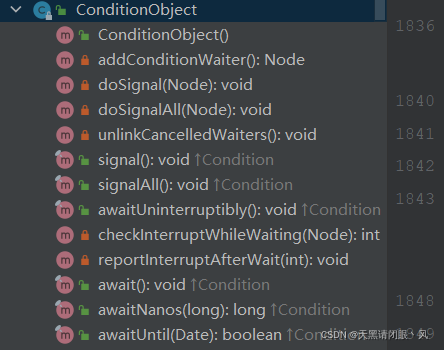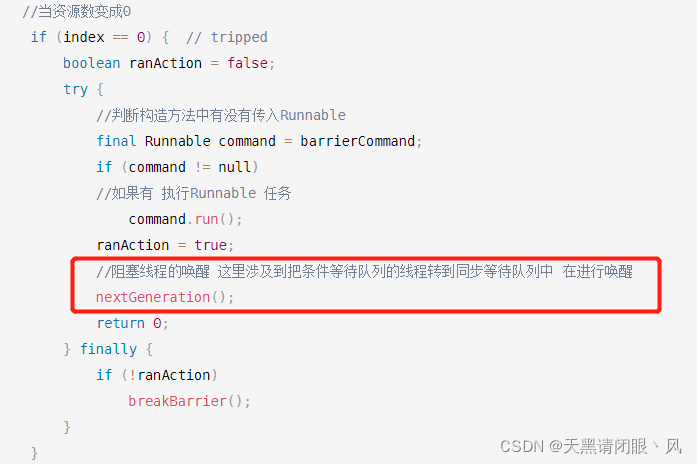CyclicBarrier详解
CyclicBarrier
字面意思回环栅栏(循环屏障),通过它可以实现让一组线程等待至某个状态(屏障点)之后再全部同时执行。叫做回环是因为当所有等待线程都被释放以后,CyclicBarrier可以被重用
CyclicBarrier的使用
重要方法
// parties表示屏障拦截的线程数量,每个线程调用 await 方法告诉 CyclicBarrier 我已经到达了屏障,然后当前线程被阻塞。
public CyclicBarrier(int parties)
// 用于在线程到达屏障时,优先执行 barrierAction,方便处理更复杂的业务场景(该线程的 执行时机是在到达屏障之后再执行)
public CyclicBarrier(int parties, Runnable barrierAction)
//屏障 指定数量的线程全部调用await()方法时,这些线程不再阻塞
// BrokenBarrierException 表示栅栏已经被破坏,破坏的原因可能是其中一个线程 await() 时被中断或者超时
public int await() throws InterruptedException, BrokenBarrierException
public int await(long timeout, TimeUnit unit) throws InterruptedException, Bro kenBarrierException, TimeoutException
//循环 通过reset()方法可以进行重置
public void reset()
案例
@Slf4j
public class CyclicBarrierLOL {
private static final CyclicBarrier cbr = new CyclicBarrier(6);
private static int aa ;
private void ChooseHero(String route) {
new Thread(()->{
log.info(route + "选择好了英雄,等待进入游戏");
try {
cbr.await();
} catch (InterruptedException e) {
e.printStackTrace();
log.info(route+"已被中断,无法进行游戏");
} catch (BrokenBarrierException e) {
e.printStackTrace();
log.info(route+"等待超时,无法进行游戏");
}
}).start();
}
public static void main(String[] args) throws Exception {
CyclicBarrierLOL lol = new CyclicBarrierLOL();
String[] rotes = {"上单","打野","中单","ADC","辅助"};
while (true){
log.info("进入英雄选择界面,等待英雄选择");
for (int i = 0; i < 5; i++) {
String rote = rotes[i];
lol.ChooseHero(rote);
}
cbr.await();
log.info("英雄选择完成,开始进入游戏");
aa++;
if (aa == 2) return ;
}
}
}
源码分析
CyclicBarrier的源码分析需要有ReentrantLock源码的基础。
CyclicBarrier的构造方法,第一个参数:资源数 第二个参数:执行任务 当资源数为0的时候调用这个任务
这个资源数可以理解为Semaphore和CountDownLatch的资源数,只不过Semaphore中持有资源数的线程才能通过,CountDownLatch中资源数不为0的时候线程阻塞。
在CyclicBarrier中定义的parties和count都等于资源数。其中this.parties用于线程重置,this.count 用于计数器控制线程是否阻塞

阻塞部分
当调用await()方法的时候进入阻塞路程

private int dowait(boolean timed, long nanos)
//如果通过await调用dowait 那么timed = false
//如果通过await(long timeout, TimeUnit unit) 调用dowait 那么timed 就为true
throws InterruptedException, BrokenBarrierException,
TimeoutException {
//上锁操作 为什么要上锁 后续逻辑用到ReentrantLock条件锁的await方法 必须要先加锁才能使用await方法
final ReentrantLock lock = this.lock;
lock.lock();
try {
//这部分不是逻辑重点 不用管
final Generation g = generation;
if (g.broken)
throw new BrokenBarrierException();
if (Thread.interrupted()) {
breakBarrier();
throw new InterruptedException();
}
//重点逻辑从这里了开始
//资源数减一
int index = --count;
//当资源数变成0
if (index == 0) { // tripped
boolean ranAction = false;
try {
//判断构造方法中有没有传入Runnable
final Runnable command = barrierCommand;
if (command != null)
//如果有 执行Runnable 任务
command.run();
ranAction = true;
//阻塞线程的唤醒 这里涉及到把条件等待队列的线程转到同步等待队列中 在进行唤醒
nextGeneration();
return 0;
} finally {
if (!ranAction)
breakBarrier();
}
}
// 当资源数不为0的时候执行自旋逻辑
for (;;) {
try {
if (!timed)
//这个trip 是 private final Condition trip = lock.newCondition();
//这里用到了ReentrantLock的条件队列, trip.await()阻塞当前线程并且进入条件阻塞队列
//同时await方法会释放锁对象
trip.await();
//如果传入等待超时时间
else if (nanos > 0L)
//调用含有等待超时的阻塞方法
nanos = trip.awaitNanos(nanos);
} catch (InterruptedException ie) {
//抛出中断异常的后续操作
if (g == generation && ! g.broken) {
//底层的代码就是唤醒线程
breakBarrier();
throw ie;
} else {
Thread.currentThread().interrupt();
}
}
if (g.broken)
throw new BrokenBarrierException();
if (g != generation)
return index;
//等待超时后执行的逻辑
if (timed && nanos <= 0L) {
//底层的代码就是唤醒线程
breakBarrier();
throw new TimeoutException();
}
}
} finally {
//当资源数=0的那部分代码执行完成后 最终还会执行这行代码
//释放锁 这是ReentrantLock 释放锁的逻辑 唤醒同步等待队列中线程 这部分逻辑不在分析
// 如果资源数不为0 不会执行该行代码 因为不为0 线程阻塞并且在条件等待队列中 不会往下执行
lock.unlock();
}
}
阻塞流程一个重点就是阻塞进入队列对应着就是trip.await();在看这部分源码之前先来看下AQS对于条件阻塞队列的实现


条件阻塞队列是一个单向链表,如何创造这个链表就在addConditionWaiter()方法当中
private Node addConditionWaiter() {
//定义一个节点等于链表的尾节点 一开始这个尾节点自然是null 因为还没有链表
Node t = lastWaiter;
// If lastWaiter is cancelled, clean out.
if (t != null && t.waitStatus != Node.CONDITION) {
unlinkCancelledWaiters();
t = lastWaiter;
}
//创建一个节点 Node.CONDITION 表示一个状态 等于-2 把当前线程和状态赋值给头节点
Node node = new Node(Thread.currentThread(), Node.CONDITION);
//如果尾节点为null
if (t == null)
//链表的头节点等于创建出来的节点
firstWaiter = node;
else
//否则链表的下一个节点等于创建出来的节点
t.nextWaiter = node;
//链表的尾节点等于创建出来的节点
lastWaiter = node;
//到此创建了一个新链表并且完成线程入队操作
return node;
}
总结就是addConditionWaiter();方法如果没有链表创建链表完成入队,如果已经创建了链表就直接入队
在回过头来看trip.await();
public final void await() throws InterruptedException {
if (Thread.interrupted())
throw new InterruptedException();
//创建链表并且如队
Node node = addConditionWaiter();
//解锁操作
int savedState = fullyRelease(node);
int interruptMode = 0;
//阻塞操作
while (!isOnSyncQueue(node)) {
//线程被阻塞在这个地方
LockSupport.park(this);
if ((interruptMode = checkInterruptWhileWaiting(node)) != 0)
break;
}
//当线程被唤醒的时候重新获取锁acquireQueued(node, savedState)底层通过CAS获取锁
//为什么要重新获取锁 dowait的finlly方法中时解锁操作 所以要先获取锁
//如果此时有其他线程竞争,CAS获取锁失败后继续阻塞
//acquireQueued这个方法就是ReentrantLock底层获取锁的方法 不再分析了
if (acquireQueued(node, savedState) && interruptMode != THROW_IE)
interruptMode = REINTERRUPT;
if (node.nextWaiter != null) // clean up if cancelled
unlinkCancelledWaiters();
if (interruptMode != 0)
reportInterruptAfterWait(interruptMode);
}
来看下解锁方法fullyRelease(node)
final int fullyRelease(Node node) {
boolean failed = true;
try {
//获取资源状态 之前有说过如果要加锁 通过CAS把State从0改成1
int savedState = getState();
//解锁的逻辑 这部分和之前ReentrantLock解锁逻辑是一样的通过CAS把1改成0然后设置独占的线程为null 就不在展开了
if (release(savedState)) {
//解锁成功返回资源状态
failed = false;
return savedState;
} else {
throw new IllegalMonitorStateException();
}
} finally {
if (failed)
node.waitStatus = Node.CANCELLED;
}
}
总结下来就是 trip.await(); 作用就是创建链表入队,释放锁 阻塞入队线程。
dowait(boolean timed, long nanos)中当CyclicBarrier的资源数不为0的时候,进行上述操作阻塞当前线程然后进入条件等待队列,然后释放锁,进行下一个线程的操作。
当资源数等于0的时候就执行了这部分代码,重点是nextGeneration(); 这个是比较精髓的点

private void nextGeneration() {
//重点就在于这个方法
trip.signalAll();
// 重复利用资源数,开始新一轮的屏障
count = parties;
generation = new Generation();
}
public final void signalAll() {
if (!isHeldExclusively())
throw new IllegalMonitorStateException();
//获取等待条件队列的头节点
Node first = firstWaiter;
if (first != null)
//把头节点传入
doSignalAll(first);
}
private void doSignalAll(Node first) {
//把首尾节点设置为null
lastWaiter = firstWaiter = null;
do {
//设置一个节点等于 头节点的下一个节点
Node next = first.nextWaiter;
//设置头节点的下一个节点为null 也就是说把头节点指向下一个节点的指针设置为null
//由于之前就设置了头节点==null 再把指针也设置为null 这样头节点就被删除了 也就是出队的意思
first.nextWaiter = null;
//进入同步队列
transferForSignal(first);
//由于第一个头节点被删除了 那么第二个节点就要成为头节点
first = next;
//精髓点在于 当头节点不为空进行了do while 的循环 直到把所有节点都出队并且进入到同步队列
} while (first != null);
}
doSignalAll方法就是单向链表出队,进入同步等待队列
再来看进入同步队列的方法
final boolean transferForSignal(Node node) {
if (!compareAndSetWaitStatus(node, Node.CONDITION, 0))
return false;
//如果双向链表不存在,创建双向链表,同时把节点添加到双向链表中
//这部分就是把条件等待队列的线程全部添加到同步等待队列中
//这部分的源码在ReentrantLock源码解析的时候分析过就不在分析了
Node p = enq(node);
//获取链表的一个状态(是否可以唤醒)
int ws = p.waitStatus;
//如果状态满足唤醒阻塞线程
if (ws > 0 || !compareAndSetWaitStatus(p, ws, Node.SIGNAL))
LockSupport.unpark(node.thread);
return true;
}
当nextGeneration()执行完成后,return 0 最后还会执行dowait(boolean timed, long nanos) finally中的lock.unlock();方法。这个方法就是唤醒同步等待队列的方法。这部分逻辑就是ReentrantLock的解锁逻辑。
CyclicBarrier源码流程总结
CyclicBarrier cbr = new CyclicBarrier(3, new Runnable() {
@Override
public void run() {
System.out.println("begin run");
}
});
一上面构造出的CyclicBarrier为例子,此时的资源数是3
当调用cbr.await();的时候底层调用dowait(false, 0L)方法。
dowait(false, 0L)的执行流程:
一开始就加了ReentrantLock的锁,资源数(一开始是3)减1,判断资源数是不是等于0,如果不等于0通过自旋调用 trip.await();其中trip是ReentrantLock的条件锁,
trip.await();的作用:
- 底层调用
addConditionWaiter()完成创建单向链表并且进入该队列 - 调用
fullyRelease(node)完成释放锁 - 调用
LockSupport.park(this);阻塞线程 此时线程就是阻塞在这个地方 - 当线程被唤醒的时候调用
acquireQueued(node, savedState)通过CAS获取ReentrantLock的锁
当资源数判断为0时,执行构造方法中的Runnable任务。然后条用nextGeneration(); nextGeneration();底层调用trip.signalAll(); 内部调用了doSignalAll。doSignalAll作用是条件等待队列的线程出队并且进入同步等待队列中。
nextGeneration();执行完成后 执行 dowait(false, 0L)的finally里面的方法 lock.unlock();此时释放ReentrantLock的锁。
释放锁自然会唤醒ReentrantLock同步等待队列中阻塞的线程。
到此CyclicBarrier完成一轮的阻塞-唤醒流程